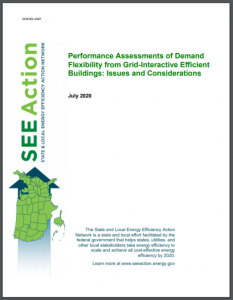Full Title: Performance Assessments of Demand Flexibility from Grid-Interactive Efficient Buildings: Issues and Considerations
Author(s): Steven R Schiller, Lisa C Schwartz, Sean Murphy
Publisher(s): State and Local Energy Efficiency Action Network & Lawrence Berkeley National Laboratory
Publication Date: July 30, 2020
Full Text: Download Resource
Description (excerpt):
This SEE Action Network report explains basic concepts and fundamental considerations for assessing the actual demand flexibility performance of buildings participating in demand flexibility programs and responding to time-varying retail rates. Demand flexibility is the capability of distributed energy resources (DERs) to adjust a building’s load profile across different timescales. Assessments determine the timing, location, quantity, and quality of grid services provided.
The results can be used for financial settlements and to improve performance of demand flexibility, support its consideration in resource potential studies and electricity system planning, and contribute to cost-effectiveness evaluations.
While practitioners and regulators regularly find opportunities to improve performance assessments of demand-related services, to a large degree current best practices are sufficient for basic service offerings as demand flexibility is implemented today. However, advances in assessment practices will be required in a future with grid-interactive efficient buildings (GEBs) that provide continuous demand flexibility by integrating multiple DERs and flexibility modes (load shed, load shift, modulate, and generate). Example practices include using new baseline constructs—including whether baselines are even required for certain building flexibility modes or configurations, deploying more advanced metering and analytics, further developing cybersecurity standards, improving communication standards for increased interoperability, and establishing performance metrics and assessment procedures for load modulation as it is more fully defined and implemented.
This report provides information on prioritizing and designing performance assessment elements for demand flexibility programs and time-varying retail rates, assessment protocols, and research and development needs. Additional research sponsored by DOE’s Building Technologies Office1(link is external) offers more detailed technical information on assessing performance of demand flexibility, including definition of performance metrics.
